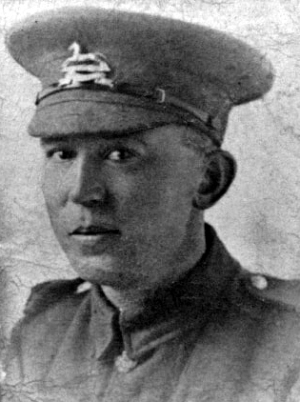
67765, Royal Army Medical Corps, 9th Cavalry Field Ambulance
Ernest Webster was born in Ossett on the 28th May 1885, the younger son of mill labourer George Webster and his wife, Eunice (nee Gunson), who were married in 1868. They had three children: Elizabeth (born 1869), Joshua (born 1877) and Ernest in 1885. George Webster, his wife Eunice and the three children, were all born in Ossett. However, Ernest was baptised at Earlsheaton St Peter’s Church on the 27th July 1885.
In 1891, the Webster family were living on the Green, Ossett. By 1901, matriarch Eunice Webster, aged 57 years, and working as a self-employed knitting machinist, was living with 15 year-old Ernest, a rag shaker, in Manor Road, close to Green House. Ernest’s father, George Webster was staying at his brother’s home in Cross Street, Ossett.
George Webster died in 1909 aged 64 years, and in 1911 his widow, Eunice was living with her 25 year-old son Ernest at Wilby Buildings, Manor Road, South Ossett, where Ernest was working as a warehouseman.
Ernest Webster’s army service record has not survived, but it is known that he enlisted at Ossett, and that he was formerly in the West Yorkshire Regiment with service number 20735. Whilst Ernest Webster appears to have enlisted in the West Yorkshire Regiment in late 1914, he did not serve overseas until after the 31st December 1915. Private Ernest Webster was posthumously awarded the British and Victory medals.
The Field Ambulance was a mobile front line medical unit (it was not a vehicle). Most came under command of a Division, and had special responsibility for the care of casualties of one of the Brigades in the Division. Each Division had three Field Ambulances. The theoretical capacity of the Field Ambulance was 150 casualties, but in battle many would simply be overwhelmed by numbers. The Ambulance was responsible for establishing and operating a number of points along the casualty evacuation chain, from the Bearer Relay Posts which were up to 600 yards behind the Regimental Aid Posts, through the Advanced Dressing Station (ADS), to the Main Dressing Station (MDS). It also provided a Walking Wounded Collecting Station, as well as various rest areas and local sick rooms. The Ambulances would usually establish 1 ADS per Brigade, and 1 MDS for the Division.
9th Cavalry Field Ambulance, Royal Army Medical Corps was attached to the 1st Cavalry Division. Private Ernest Webster died during the Battle of Cambrai, October 1918, in which his Division was involved as part of Rawlinson’s Fourth Army.
The Battle of Cambrai was a battle between troops of the British First, Third and Fourth Armies and German Empire forces during the Hundred Days Offensive of the First World War. The battle took place in and around the French city of Cambrai, between the 8th and 10th October 1918. The battle incorporated many of the newer tactics of 1918, in particular tanks, meaning that the attack was an overwhelming success with light casualties in an extremely short amount of time.
Although there were three German lines, spanning some 7,000 yards (6,400m), the sector had been quiet for some time so it was lightly garrisoned; held by the 20th Landwehr and the 54th Reserve divisions, supported by no more than 150 guns. The German defenders were unprepared for the “hurricane bombardment” by 324 tanks, closely supported by infantry and aircraft.1
The “Ossett Observer”, 2 had this obituary for Private Ernest Webster:
“Well-Known South Ossett Man Killed – A well-known South Ossett young man has met his death in the war in the person of Private Ernest Webster, R.A.M.C., whose home was at 32, Albert-street. He had been in the army nearly four years, and in civilian life followed the occupation of an insurance agent. He was associated with the South Ossett Church Institute cricket and football clubs. It seems that in the army he had served with the cavalry field ambulance, and that he was killed while taking a message to headquarters. His elder brother, Joshua has also been in the forces a long time, and at present is in Palestine.”
Private Ernest Webster, aged 33, the son of the late George and Eunice Webster, of Ossett, was killed in action on the 8th October 1918 and is buried at grave reference BB 26. at the Beaurevoir British Cemetery, 3 Aisne, France. Beaurevoir is a commune 25 kilometres south of Cambrai, midway between Cambrai and St Quentin. The Cemetery is in the north eastern part of the village on the south east side of the road to Malincourt.
Beaurevoir was attacked by the 2nd Australian Division on the 3rd October, 1918, and taken by the 25th Division on the 5th. Beaurevoir British Cemetery was made by the 66th Division in October, 1918, when officers and men who fell in the early part of that month were buried; and after the Armistice the graves of 70 who died in 1917-18, and were buried in the Communal Cemetery German Extension, were brought in to Rows AA, BB, B, C and G.
There are now nearly 300, 1914-18 war casualties commemorated in this site. Of these, almost 50 are unidentified and special memorials are erected to four soldiers from the United Kingdom known or believed to be buried among them.
References:
2. “Ossett Observer”, 19th October 1918